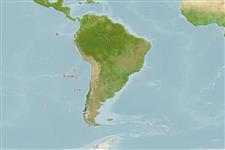>
Gadiformes (Cods) >
Moridae (Morid cods)
Etymology: Physiculus: Diminutive of Greek, physa = tube; hexacytus: From the Greek hexa for six and kytos for cavity, referring to its six pyloric caeca (Ref. 43973).
Environment: milieu / climate zone / depth range / distribution range
Ecología
marino batidemersal; rango de profundidad 230 - 340 m (Ref. 43973). Deep-water
Southeast Pacific: submarine seamounts of the central and southern part of the Nazca Ridge.
Tamaño / Peso / Age
Maturity: Lm ? range ? - ? cm
Max length : 18.9 cm SL macho / no sexado; (Ref. 43973)
Short description
Claves de identificación | Morfología | Morfometría
Espinas dorsales (total) : 0; Radios blandos dorsales (total) : 72 - 78; Espinas anales: 0; Radios blandos anales: 70 - 77; Vértebra: 58 - 60. Short chin barbel; pyloric caeca 6; spindle-shaped light organ on abdomen near line linking ends of the bases of the pelvic fins; abdominal cavity extending to the level of the 8-9th ray of the anal fin. Caudal fin rounded.
Type specimen taken from 330 m depth (Ref. 9068).
Life cycle and mating behavior
Madurez | Reproducción | Puesta | Huevos | Fecundidad | Larva
Parin, N.V., 1984. Three new species of the genus Physiculus and other fishes (Moridae, Gadiformes) from the submarine seamounts of the southeastern Pacific Ocean. J. Ichthyol. 24(4):46-60. (Ref. 43973)
IUCN Red List Status (Ref. 130435: Version 2024-2)
Threat to humans
Harmless
Human uses
Pesquerías: sin interés
Herramientas
Special reports
Download XML
Fuentes de Internet
Estimates based on models
Preferred temperature (Ref.
123201): 4.4 - 13.1, mean 10.6 °C (based on 41 cells).
Phylogenetic diversity index (Ref.
82804): PD
50 = 0.5000 [Uniqueness, from 0.5 = low to 2.0 = high].
Bayesian length-weight: a=0.00389 (0.00192 - 0.00787), b=3.11 (2.93 - 3.29), in cm total length, based on LWR estimates for this (Sub)family-body shape (Ref.
93245).
Nivel trófico (Ref.
69278): 3.4 ±0.4 se; based on size and trophs of closest relatives
Resiliencia (Ref.
120179): Medio, población duplicada en un tiempo mínimo de 1.4-4.4 años (Assuming tmax>3).
Fishing Vulnerability (Ref.
59153): Low vulnerability (13 of 100).
